- Adult Heart DiseaseDiseases of the arteries, valves, and aorta, as well as cardiac rhythm disturbances
- Pediatric and Congenital Heart DiseaseHeart abnormalities that are present at birth in children, as well as in adults
- Lung, Esophageal, and Other Chest DiseasesDiseases of the lung, esophagus, and chest wall
- ProceduresCommon surgical procedures of the heart, lungs, and esophagus
- Before, During, and After SurgeryHow to prepare for and recover from your surgery
Atrial Fibrillation Awareness Month

Atrial fibrillation, also known as Afib or AF, is the most common type of heart arrhythmia (irregular heartbeat). The US Centers for Disease Control and Prevention estimates that up to 6 million people in the US have Afib.
StopAfib.org, a global atrial fibrillation patient organization, has helped lead the Atrial Fibrillation awareness campaign, which is designed to increase the understanding of Afib and better inform patients and health care providers about this complex condition.
When a person has Afib, the beating in the upper chambers of the heart (atria) is unpredictable and sometimes rapid. As a result, blood doesn’t flow as well as it should from the atria to the lower chambers of the heart (ventricles). Normally, the heart beats 60 to 100 times per minute. When a person has Afib, the heart rate can be as high as 175 beats per minute.
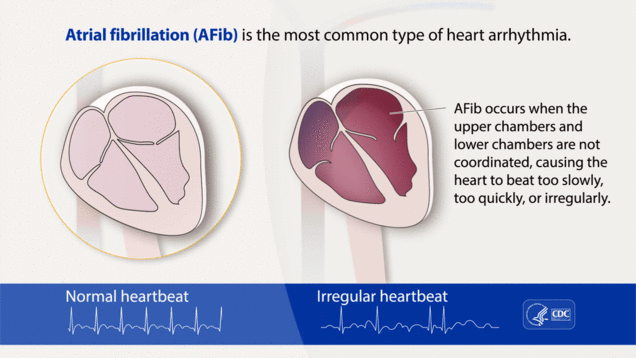
Afib itself is not life threatening. However, the irregular heartbeats associated with Afib can cause blood to collect in the heart and potentially form a clot. The clot could break free and travel to a person’s brain, causing a stroke. The National Stroke Association reports that Afib raises a person’s risk for stroke by 500%, and Afib-related strokes cause more deaths than other strokes.
Diagnosing and treating Afib may prevent 60 to 80% of strokes, according to the American Stroke Association. Sometimes people with Afib will not have any symptoms. However, others may experience one or more of the following:
- Irregular heart beat
- Heart palpitations (rapid, fluttering, or pounding)
- Dizziness or lightheadedness
- Shortness of breath
- Chest pain or pressure
- Extreme fatigue
Afib generally does not go away. Your health care team can explain the various treatment choices and help you develop a plan of care.
Treatment for Afib can include:
- Medications to control the heart’s rhythm and rate
- Blood-thinning medication to prevent blood clots from forming
- Surgery
For more information, visit Atrial Fibrillation or the CDC website.
Thoracic Aortic Aneurysm and Aortic Dissection Awareness Month
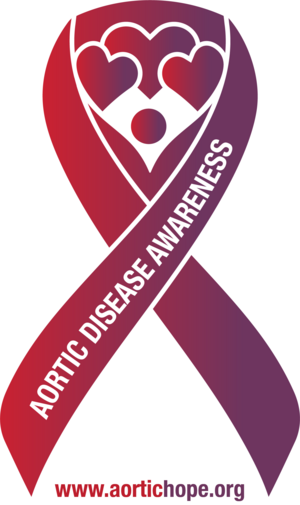
What are thoracic aortic aneurysm and aortic dissection?
Thoracic Aortic Aneurysm and Aortic Dissection describe forms of aortic disease. When the walls of a section of blood vessel become weak and thin, it results in a bulging or ballooning of the vessel that is commonly called an aneurysm. Dissection is the tearing of a blood vessel’s inner lining, causing blood to leak between the layers of the vessel wall. An aneurysm may tear (dissect) or completely rupture. Under certain conditions, a blood vessel may dissect even when there is no aneurysm.
When the aneurysm and/or dissection involve the aorta (the main artery leading away from the heart), the bulging and tearing are considered among the most serious, life-threatening conditions. However, the diseased aorta can be successfully treated, especially when found before an emergency occurs. The US National Center for Health Statistics reports almost 15,000 aorta-related deaths (including both the thoracic and abdominal aorta) each year.
For more information, visit Aortic Dissection and Thoracic Aortic Aneurysm.
Visit Aortic Hope to learn more about receiving support and joining a community of aortic disease patients, survivors, and caregivers. This community’s goals are to spread hope, create awareness, and provide support during the recovery and management of aortic disease.
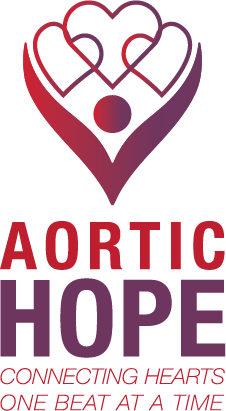
Families, caregivers, charities and research groups throughout the US observe September as Childhood Cancer Awareness Month—a time to honor and remember children and families affected by cancer.
Cancer is the leading cause of death by disease in children. The American Cancer Society (ACS) estimates that about 10,500 children in the US under the age of 15 will be diagnosed with cancer in 2021. While childhood cancer rates have been increasing slightly over the past several years, the ACS reports that because of major advances in treatment, more than 80% of children with cancer now survive 5 years or more.
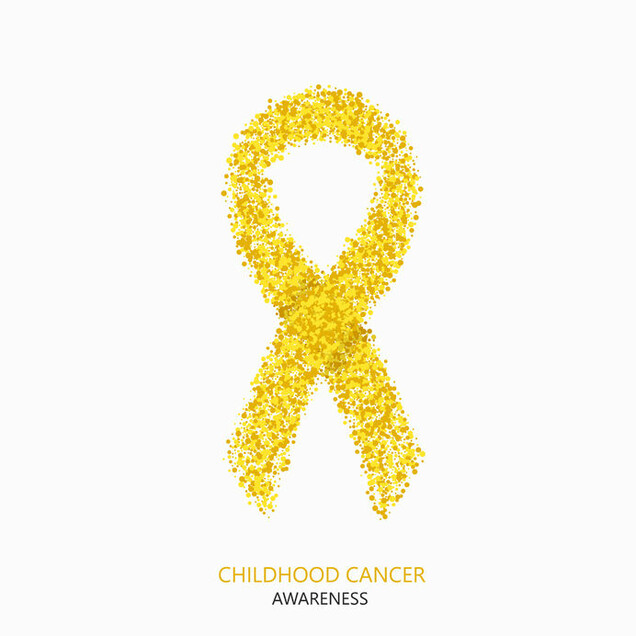
According to the ACS, the most common types of childhood cancers are:
- Leukemia
- Brain and other central nervous system tumors
- Neuroblastoma
- Wilms tumor
- Lymphoma (including both Hodgkin and non-Hodgkin)
- Rhabdomyosarcoma
- Retinoblastoma
- Bone cancer (including osteosarcoma and Ewing sarcoma)
The causes of most childhood cancers are not known. About 5% of all cancers in children are caused by a genetic mutation that can be passed from parents to their children, according to the National Cancer Institute (NCI).
Many cancers in children can be found early, but some cancers in children can be hard to recognize right away. The NCI recommends that parents schedule regular medical check-ups for their children and watch for any unusual signs or symptoms that do not go away. These include:
- Unusual lump or swelling
- Unexplained paleness and loss of energy
- Easy bruising
- Ongoing pain in one area of the body
- Limping
- Unexplained fever or illness that doesn’t go away
- Frequent headaches, often with vomiting
- Sudden eye or vision changes
- Sudden unexplained weight loss
Other symptoms are also possible, depending on the type of cancer.
Children’s Cardiomyopathy Awareness Month—recognized in September and sponsored by the Children’s Cardiomyopathy Foundation (CCF)—is designed to educate the public about pediatric cardiomyopathy, a potentially life‐threatening heart condition that affects how the heart muscle pumps blood.
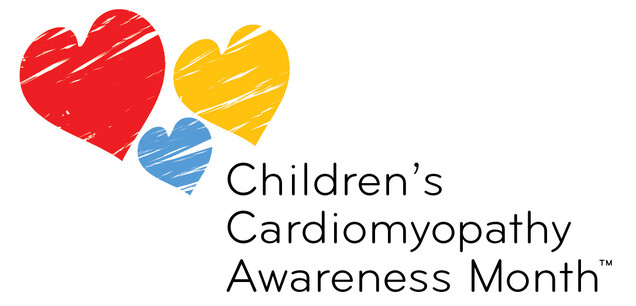
Pediatric cardiomyopathy is the number one cause of sudden cardiac arrest and heart transplants in children, and according to the Pediatric Cardiomyopathy Registry, one in every 100,000 children in the US under the age of 18 is diagnosed with cardiomyopathy.
Cardiomyopathy is a chronic disease in which the heart muscle becomes abnormally enlarged, thickened, or rigid. As a result, the heart can no longer contract or relax normally. As cardiomyopathy worsens, the heart becomes weaker. Eventually, the heart loses its ability to pump blood through the body and maintain a normal electrical rhythm. Irregular heartbeats (arrhythmias) and heart failure may occur.
Cardiomyopathy is a complex disease with symptoms and causes that vary considerably. Some affected children may have no symptoms while others may have a heart murmur, show evidence of heart enlargement, and experience shortness of breath, rapid breathing, or extreme fatigue. The cause of cardiomyopathy is not always identified, but viral infections and familial inheritance are primary causes.
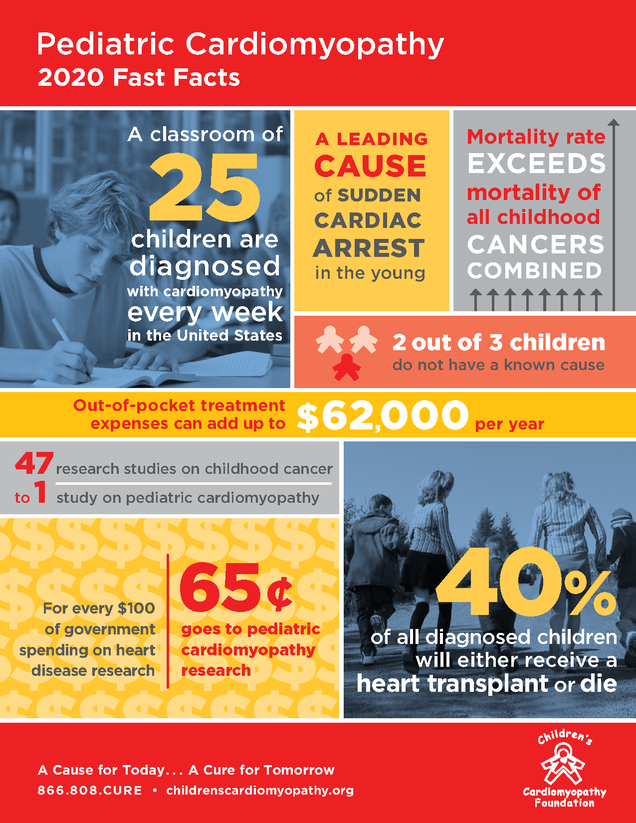
The CCF reports that many children with cardiomyopathy can lead a relatively normal life with few lifestyle restrictions. There will be more frequent doctor visits for monitoring of the condition and daily cardiac medication; and depending on the cause, type and stage of the disease, other modifications may involve diet, restriction from competitive, contact sports, and minor school accommodations.
For more information, visit the Children’s Cardiomyopathy Foundation website.
WORLD LUNG DAY
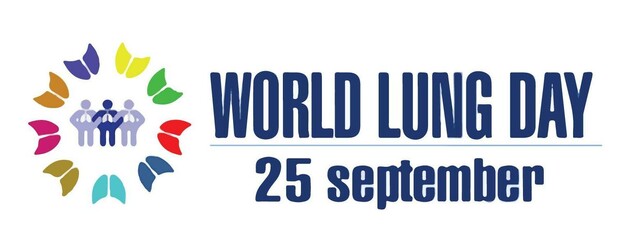
World Lung Day—established by The Forum of International Respiratory Societies (FIRS)—provides an opportunity to unite and advocate for better lung health globally. Organizations from around the world, including The Society of Thoracic Surgeons, have joined the campaign to shine a spotlight on the alarming statistics related to lung health and to work toward clean air and healthy lungs for all.
According to FIRS and the Global Impact of Respiratory Disease Report (2017):
- 65 million people suffer from chronic obstructive pulmonary disease (COPD) and 3 million die from it each year, making it the third leading cause of death worldwide
- 10 million people develop tuberculosis and 1.8 million die from it each year, making it the most common lethal infectious disease
- 1.6 million people die from lung cancer each year, making it the deadliest cancer
- 334 million people suffer from asthma, making it the most common chronic disease of childhood. It affects 14 percent of children globally − and rising
- Pneumonia kills millions of people each year making it a leading cause of death in the very young and very old
- At least 2 billion people are exposed to toxic indoor smoke; 1 billion inhale polluted outdoor air; and 1 billion are exposed to tobacco smoke
- Passive smoke exposure also leads to respiratory disease. Since 1964, about 2.5 million non-smokers died from health problems caused by exposure to second-hand smoke
WORLD HEART DAY
Created by the World Heart Federation, World Heart Day—September 29—serves as a platform to bring awareness to cardiovascular diseases (CVDs), which include heart disease and stroke.

According to the World Health Organization (WHO), CVDs are the world’s leading cause of death globally, claiming 17.5 million lives each year. Most cardiovascular diseases can be prevented by addressing behavioral risk factors such as tobacco use, unhealthy diet and obesity, physical inactivity, and harmful use of alcohol. The WHO reports that at least 80% of premature deaths from heart disease and stroke can be avoided if these risk factors are eliminated.
Symptoms of a heart attack include:
- Pain or discomfort in the center of the chest
- Pain or discomfort in the arms, the left shoulder, elbows, jaw, or back
In addition, people may have difficulty breathing or shortness of breath, feel sick or vomit, feel light-headed or faint, break into a cold sweat, and become pale.
The most common symptom of a stroke is sudden weakness of the face, arm, or leg, most often on one side of the body. Other symptoms include:
- Numbness of the face, arm, or leg, especially on one side of the body
- Confusion, difficulty speaking or understanding speech
- Difficulty seeing with one or both eyes
- Difficulty walking, dizziness, loss of balance or coordination
- Severe headache with no known cause
- Fainting or unconsciousness
People experiencing these symptoms should seek medical care immediately.
The World Heart Federation encourages everyone to make heart-healthy choices wherever they live, work, and play.


